|
|
|
|
|
|
|
 KOSHER
SHOPPER Leelee Sobieski of
Manhattan trekked to Brooklyn to pick up a ketubah, a Jewish
marriage contract for her recent wedding. While in the neighborhood
she dropped in at Abraham Bandaís Pomegranate, the worldís most
fabulous kosher food market, on Coney Island Avenue, where she was
assisted by Gabriel Boxer. KOSHER
SHOPPER Leelee Sobieski of
Manhattan trekked to Brooklyn to pick up a ketubah, a Jewish
marriage contract for her recent wedding. While in the neighborhood
she dropped in at Abraham Bandaís Pomegranate, the worldís most
fabulous kosher food market, on Coney Island Avenue, where she was
assisted by Gabriel Boxer.
|
|
Back to Top
|
|
|
|
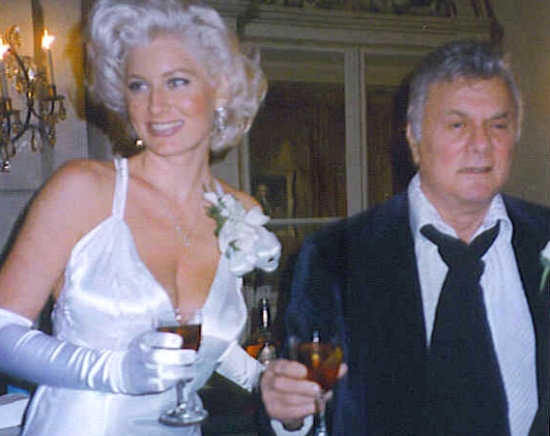
Tony Curtis and his future bride, Jill Vandenberg,
at Emanuel gala in 1995
Photo by Tim
Boxer |
Tony Curtis
Gives Back
ONY CURTIS, one of
the last of the great Hollywood legends, was also one of
those stars who rediscovered their roots and decided to give
back.
Born Bernard Herschel Schwartz
in the Bronx, Tony grew up with immigrant Hungarian
parents. His mother was Helen Klein; his
father Emanuel Schwartz, a tailor in
Manhattan. Tony had Hungarian on his tongue until he went to
public school.
So it was no wonder that his personal
passion later in life ó his primary passions were acting and
painting ó was the Emanuel Foundation for Hungarian Culture,
named for his father. Tony visited his fatherís birthplace,
Matszalka, in 1987 and saw the shul and cemetery in total
disrepair.
"A lot of the stones were toppled over, not
from vandals as much as from time," he told me in 1992 when
he filmed Naked in New York for Martin Scorsese.
"There they sit, silent survivors of that period of time. We
must maintain those monuments as an education for all
Hungarian young people."
Through the Emanuel Foundation, Tony focused
on Budapest where he helped restore the ancient Dohany
Synagogue, erected a Holocaust memorial tree on the grounds,
and built a Raoul Wallenberg Park to honor righteous
gentiles who saved Jewish lives.
He embarked on his mission out of respect
for his parentsí heritage, which they passed on to him. He
said that heritage was private. He didnít wear his religion
as a cloak visible in public.
"When you live in a society where everybody
is equal, your Jewishness or gentileness, or whatever you
are, becomes a very personal experience. Itís like prayer,
itís personal."
He said he would go to the temple on the
High Holy Days. On a trip to Israel heíd go to the Western
Wall every morning. "I put my notes in the Wall. A guy came
up and helped me lay tefilin. I like that environment."
The Emanuel Foundation held its annual
fundraising dinners in New York. In 1995 Tony addressed the
guests at the Pierre Hotel. He was accompanied by a
statuesque beauty, Jill Vandenberg, a
25-year-old horseback instructor. She was a picture of
whiteness: white satin gown with white gloves, and platinum
blonde hair that complemented Tonyís silvery mane.
"Iím not an actress," she said. "Thatís why
we get along."
Dr. Norman Lamm, president
of Yeshiva University, whispered, "Itís interesting to see
how everyoneís trying to get close to her ó the women with
envy and the men with jealousy."
Tony made Jill his sixth wife three years
later.
The foundationís late executive vice
president, Andor Weiss of Brooklyn,
revealed how he enlisted Tony. Andor wrote a letter: "Why
arenít you doing something for the Jewish community in
Hungary?" Tony invited him to meet in Los Angeles.
"I told him he has to come to the Beverly
Grand Hotel which has a kosher restaurant," Andor recalled.
"While we talked he drew a picture on the tablecloth of a
woman lighting two Shabbos candles, with challah on the
table. I knew then that his answer would be positive."
At the foundationís 1998 dinner at the St.
Regis Hotel, Kelly Curtis filled in for her
father. Kelly and Jamie Leigh Curtis are
daughters of Tonyís first wife, Janet Leigh.
Kelly told me she went to church with her
Presbyterian mother, but also to temple with her friends.
She connected to her identity when she went to Hungary with
her father in 1987.
"When I look at myself, I feel Jewish," she
said. "I have a very strong Jewish identity running through
me ó itís my legacy."
Tony Curtis died of a heart attack at age 85
on Wednesday, Sept. 29, at his home in Henderson, Nevada.
|
|
Back to Top
|
|
|
|
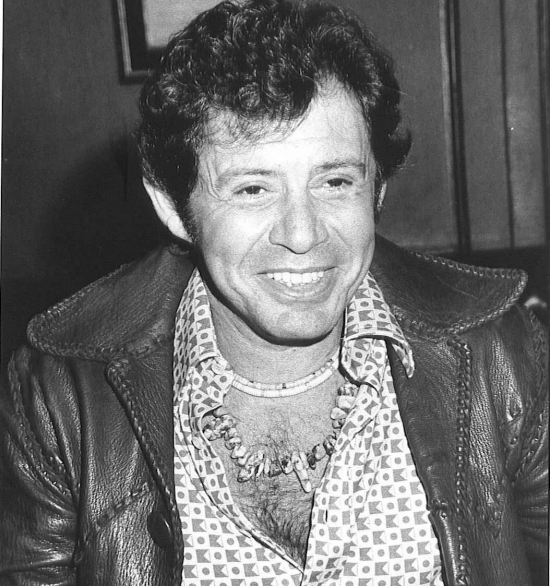
Eddie Fisher 1989
Photo by Tim
Boxer |
The Eddie
Fisher I Knew
DDIE FISHER loved
such ravishing beauties as Ann-Margret,
Angie Dickinson, Kim Novak,
Judy Garland, Juliet Prowse
and Mia Farrow among many others.
He married five times.
The heartthrob of the
Ď50s started out as a ten-year-old singer in his
Philadelphia hometown. On the High Holidays He made $20 as
the soloist with the tall white yarmulke.
"Canít you find a
nice Jewish girl, Eddie?" I asked of the man whose rendition
of Oh, My Pa Pa opened the tear ducts of a generation.
"For what I have been
through it is too late for me to find a nice Jewish girl in
show business. The woman I have now is not Jewish, but she
is a very spiritual person, very religious in her thinking."
The woman of that
moment was a psychotherapist named Lyn Davis,
a tall gorgeous blond from L.A.
"She has changed a
lot of my thinking. Not as far as being a Jew," he insisted.
"I am a Zionist. I believe in America, I believe in Israel."
This was in 1981 at
Carrie Fisherís cozy apartment on Central
Park West. Eddie was staying there while Carrie, of Star
Wars fame and his daughter from Debbie Reynolds,
was making a movie in California.
It was a time when he
was extricating himself from an abyss of senseless gambling
in the casinos (reportedly losing $20 million) and
self-destructive drug abuse. Lyn was his roommate before
marrying Norman Lear.
"Carrie has played a
major role in my turnaround," he said. "She made me come to
New York. That was my beginning. A new beginning. A renewed
Jew."
The end came on Sept.
22, when he succumbed to complications of hip surgery at age
82 at his home in Berkeley, Calif.
|
|
Back to Top
|
|
|
|
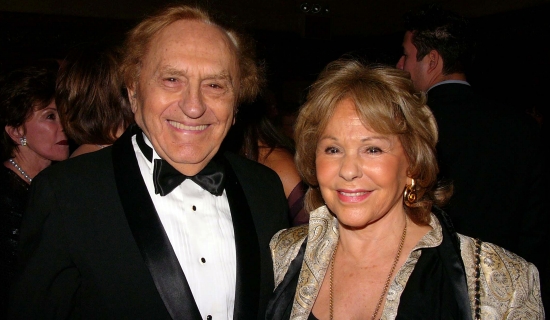
Joseph
Stein and wife Elisa Loti 1990
Photo by Tim
Boxer |
Joe Stein On
The Great White Way
LAYWRIGHT Joseph Stein,
who died at age 98 on Oct. 24 in Manhattan, was an original
member of Minyan of the Stars. The organization encouraged
show business personalities to celebrate Jewish holidays and
traditions.
One of the first gatherings took
place at Steinís home on Park Avenue. It was Chanukah 1990.
Lou Jacobi looked around and exclaimed, "We have show
people here, even a scout from MGM. MGMóMy Gantze Mishpocha
[my whole family]!"
His mishpocha included Topol,
Elie Wiesel, Theodore Bikel, Marvin Hamlisch, Zalman
Mlotek, Dr. Ruth Westheimer, Sylvia Miles, Marilyn
Michaels and her mother Freidele Oysher.
Folksinger Oscar Brand
raised his guitar and sang in Yiddish and English. He was
followed by Bruce Adler and Jacobi who sang their
versions of "Oy Chanukah, Oy Chanukah."
Stein won a Tony Award for best
author of a musical for Fiddler on the Roof, which
opened in 1965 and lasted six years, breaking Broadway
records at the time. The show earned nine Tonys.
In a 1991 interview Stein said he
got the idea for a Tevye show from his father who lived with
his son the last year of his life. His father, Charles,
who designed womenís pocketbooks for Saks and other major
stores, used to tell stories about life in Poland before
emigrating to America.
Stein wrote the book, Sheldon
Harnick did the lyrics and Jerry Bock the music.
But they had a heck of a time trying to get it produced.
"The Jewish producers considered it too Jewish," Stein said.
One asked, "What do we do when we run out of Hadassah
benefits?"
Fred Coe, a Southern
Baptist producer, said he loved it but couldnít raise the
money. Along came the Jewish Hal Prince and the rest
is history.
While Stein succeeded in capturing
shtetl life on stage, his wife, Elisa Loti, wasnít as
lucky with a Jewish production.
She was born in Guayaquil,
Ecuador, where her father was president of the local Zionist
organization and mother was president of WIZO. Elisa came to
New York and taught at a kindergarten at Beth Jacob
Synagogue on the Upper West Side before turning to acting
and directing.
When Isaac Bashevis Singerís
Teibele and the Demon opened on Broadway in 1981,
Elisa wanted in.
"I auditioned 10 times" she told
me. "Finally I was rejected. Eve Friedman, the
author, said I didnít look Jewish." Thatís showbiz.
Two years later Elisa had better
luck on her own. She directed and starred in one of her
husbandís hit shows, Enter Laughing, in a revival
off-Broadway.
"Iíd bring a shopping bag full of
food for the actors," she said. "I want to see my actors
eat. Iím a Jewish mamaóor bag lady."
|
|
Back to Top
|
|
|
|
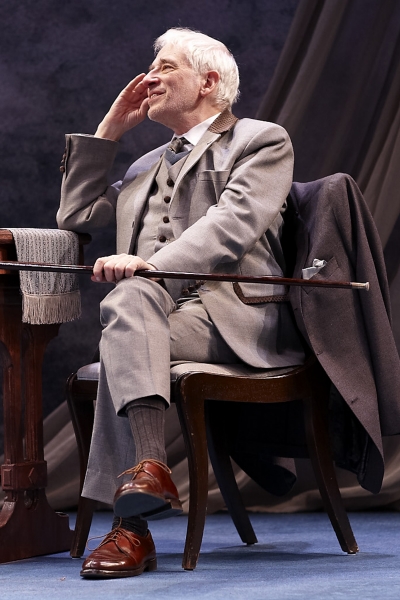
Austin Pendleton in Rosmersholm
Photo by Gregory
Costanzo |
Great Season Ahead
SAW Mike Poultonís version of
Henrik Ibsenís masterpiece, Rosmersholm, and I was
overwhelmed. This eerie play, written in 1886 by the
keen-edged Norwegian dramatist, kept me glued to my seat the
entire evening. I was so involved, I couldnít get up at
intermission, waiting apprehensively for the next bombshell
to drop onstage.
Austin Pendleton
was
outstanding as the arch conservative Doctor Kroll. Between
acting stints in New York and around the country, he teaches
at the HB Studio. Did you catch him in Wall Street: Money
Never Sleeps?
This was the Pearl
Companyís gem in its 27th season. New Yorkís premier
classical theatre company last year settled into its new
home at New York City Center.
This season began
with The Sneeze, adapted by Michael Frayn
from Anton
Chekhovís plays and stories, followed by Ibsenís
Romersholm,
and continues with Moliereís The Misanthrope
(till Feb. 20),
followed by David Davalosís Wittenberg
(March 11-April 17). Tix at
www.nycitycenter.org.
|
|
Back to Top
|
|
|
|
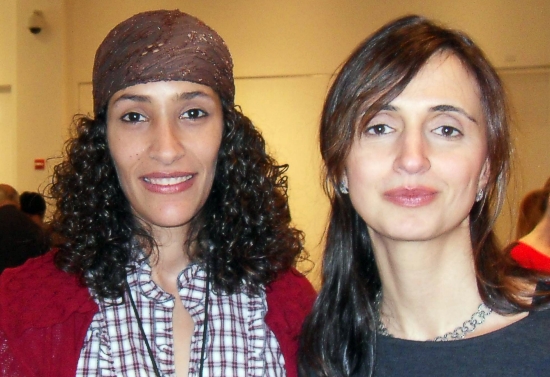
Dr.
Shenhav Cohen and Roya Hakakian
Photo by Tim Boxer |
Iran Tries To
Convert Jewish Students
CHOOL days can be stressful enough.
In Iran it is a challenging experience in more ways than usual for a
Jewish teenager.
At a recent ISEF luncheon at
Sothebyís in New York, to raise scholarship funds for needy students
in Israel, Roya Hakakian recounted growing up in
Iran after the 1979 revolution.
For a Christian, Jew or
Zoroastrian there was constant pressure at school to convert to
Islam. Roya could not evade such pressure, even at to a Hebrew day
school.
One day her class was called
to assemble in the basement near the cafeteria.
A woman, clutching a
bull horn, introduced herself as Mrs. Mohadan, the new principal.
Roya saw "a short woman,
dressed in baggy pants, with an oversize raincoat with sleeves that
reached down to her knuckles, and a scarf that covered everything
but her eyes. On top of this she had a black veil."
Roya found this strange. "If
we needed a new principal it wouldnít be a non-Jew with a black
veil. We were 15-year-old girls and we started to giggle. We thought
it was funny. We always looked for something to chatter about."
But it terrified her parents
when they heard the news.
Every afternoon the Muslim
principal gave a lecture to the young Jewish students on the merits
of Islam as a superior religion. "And she constantly warned us of
the evils of sex," Roya said.
In 1985 Roya left Iran. She
came to New York where her brothers were already living. She worked
at CBS as an associate producer at 60 Minutes and published two
volumes of Persian poetry. Currently she produces documentaries on
the Middle East and contributes to the Weekend Edition of NPRís All
Things Considered.
|
|
|
|
|